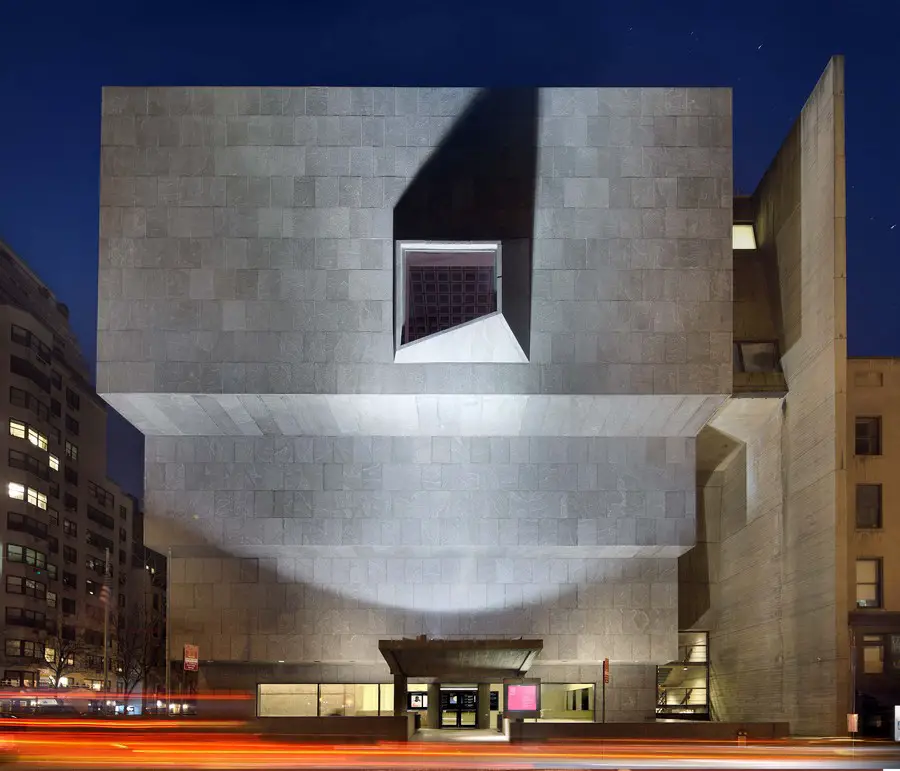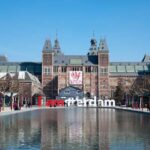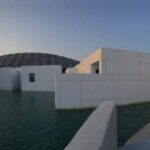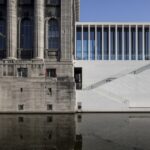Met Breuer Building Manhattan, Upper East Side Architecture, Whitney Museum New York City, Architect
Met Breuer New York Building
Metropolitan Museum of Art: Architecture on Madison Avenue, Manhattan, NYC, USA
Mar 25, 2017
The Met Breuer Restoration
2017 AIANY Design Awards – Interiors – Merit
28 Mar 2016
The Met Breuer New York City Building
Address: 945 Madison Avenue, Upper East Side
Met Breuer New York Building – former Whitney Museum of American Art
Original building date: 1966
Original Architect: Marcel Breuer with Hamilton P. Smith
Renewal date: 2016
Renewal Architects: Beyer Blinder Belle Architects & Planners LLC
On March 18, 2016, The Metropolitan Museum of Art opened The Met Breuer, its new space dedicated to modern and contemporary art.
The Met Breuer:
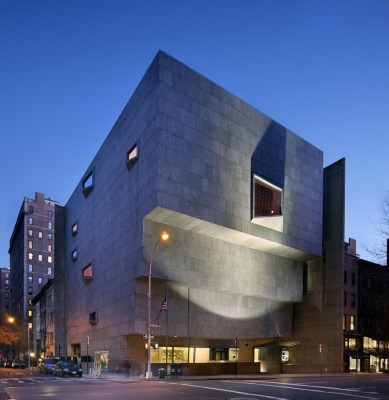
photography by Ed Lederman
Article excerpt from Metropolitan Museum of Art:
The Met Breuer Opens to the Public on March 18, 2016 Expanding The Met’s Modern and Contemporary Program
The Met Breuer Inaugural Season Features Mix of Visual Arts and Performance, Including:
‘Inhabiting Marcel Breuer’s Architecture’, an exhibition of newly commissioned architectural photographs of four iconic Marcel Breuer-designed buildings (opening November 2016).
On March 18, 2016, The Met launched its inaugural season at The Met Breuer, its new space dedicated to modern and contemporary art.
Housed in the landmark building designed by the renowned Bauhaus architect Marcel Breuer, The Met Breuer program invites visitors to engage with the art of the 20th and 21st centuries through a range of exhibitions, commissions, performances, and artist residencies all uniquely presented through the global breadth and historical reach of The Met’s unparalleled collection and resources.
“The reopening of Marcel Breuer’s iconic building on Madison Avenue represents an important chapter in the cultural life of New York City,” said Thomas P. Campbell, Director and CEO of The Met. “Whether frequent or first-time visitors to our Fifth Avenue building or The Met Cloisters, we look forward to welcoming everyone to The Met Breuer, which provides an unparalleled opportunity to experience modern and contemporary art through the lens of the global breadth and historical reach of The Met’s collection.”
The Met Breuer:
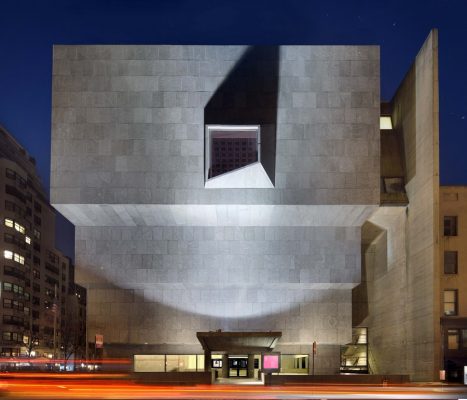
photograph : Ed Lederman
Sheena Wagstaff, the Leonard A. Lauder Chairman of The Met’s Department of Modern and Contemporary Art, added: “With the launch of The Met Breuer, we are honoring the history of this beloved building and embracing its significance to the cultural landscape of our city as we infuse it with The Met’s curatorial spirit for the public to enjoy. For our inaugural season, we have developed a far-reaching program that explores themes that stretch across history, geography, and art forms. Great works of art can transcend both time and place, as our program powerfully demonstrates.”
The Met Breuer’s program spotlights modern and contemporary art in dialogue with historic works that encompass the full range of The Met’s vast collection. The building will host both monographic and thematic exhibitions, as well as new commissions and performances. The two inaugural exhibitions at The Met are Unfinished: Thoughts Left Visible, a cross-departmental curatorial initiative that brings together works by some of the greatest artists of all time, from Titian to Louise Bourgeois, who experimented with a non finito style; and the largest exhibition to date dedicated to Indian modernist Nasreen Mohamedi. Additionally, a music installation by Artist in Residence Vijay Iyer will activate The Met Breuer’s Tony and Amie James Gallery in the lobby throughout March.
Photography is also a cornerstone of the program at The Met Breuer, including a presentation of early photographs by Diane Arbus, opening in July that will be drawn from The Met’s Diane Arbus Archive; and a series of commissioned architectural photographs that will document four seminal public buildings designed by Marcel Breuer, opening in the fall. Culminating The Met Breuer’s inaugural season, the first major survey in the United States of Kerry James Marshall, whose work asserts the place of the black figure within the narrative of Western painting, will go on view in October.
The Met Breuer:
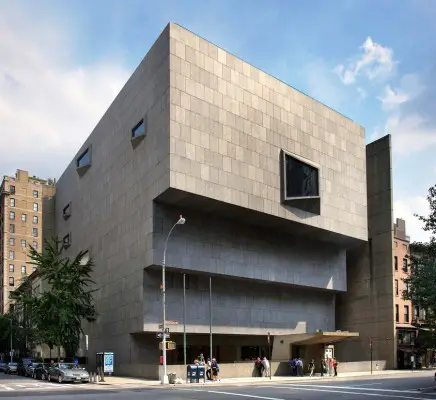
photograph : Ed Lederman
These programs will take place within an iconic building that has been restored with architect Marcel Breuer’s original vision in mind, supporting an integrated experience of art and architecture. Restoration work was completed under the guidance of Beyer Blinder Belle Architects & Planners LLC to maintain the unique character of the building’s signature attributes—including the textured concrete surfaces, bluestone floors, and bronze fixtures—with special consideration given to respecting the patina of history within the space by preserving the aesthetic of weathered areas. In addition to undertaking this extensive cleaning and restoration work, The Met also collaborated with the Whitney Museum of American Art to upgrade the building’s infrastructure systems. To enhance the building’s sunken garden, The Met commissioned landscape architect Günther Vogt to create a site-specific design and installation that includes Quaking Aspen trees planted along the west perimeter.
The Met gratefully acknowledges the following lead contributors to The Met Breuer:
Daniel and Estrellita Brodsky and Howard S. and Nancy Marks; The Carson Family Charitable Trust, Tony and Amie James, and Anthony W. and Lulu C. Wang; Cheryl and Blair Effron, Mark Fisch and Rachel Davidson, Mr. and Mrs. J. Tomilson Hill, Eliot C. and Wilson Nolen, Samantha Boardman Rosen and Aby J. Rosen, Bonnie J. Sacerdote, and Alejandro Santo Domingo; Stephanie and Peter Brant, The Eli and Edythe Broad Foundation, Ann Cox Chambers, Mr. and Mrs. Jeffrey W. Greenberg, Mary and Michael Jaharis, Michael B. Kim and Kyung Ah Park, Leonard A. Lauder, Ann Tenenbaum and Thomas H. Lee, The Dr. Mortimer and Theresa Sackler Foundation, Barrie and Deedee Wigmore, and two anonymous donors.
Major corporate support for The Met Breuer is provided by Sotheby’s.
Met Breuer Building:
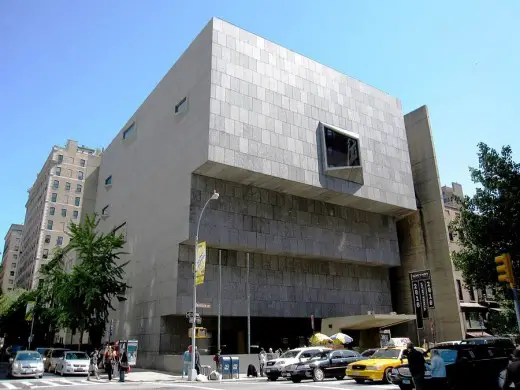
photo : Gryffindor, Wikimedia Commons
Article excerpt from hyperallergic.com:
“Prominence of name has never guaranteed the preservation of architecture. Frank Lloyd Wright’s Park Avenue Showroom was demolished in 2013 just blocks from his iconic Guggenheim Museum, Louis Kahn’s Philadelphia commercial storefront was torn down in 2014, just a couple of years after the grand unveiling of his Four Freedoms Park in New York. This month, as Marcel Breuer’s 1966 design for the Whitney Museum of American Art in Manhattan is reborn as the Met Breuer, it’s worth looking at the precarious state of two of his other modernist buildings.
Docomomo US, wrote this month that the nonprofit organization “is following recent developments concerning two other important Marcel Breuer buildings: the Central Public Library (1980) in Atlanta, Georgia and the Pirelli Tire Building (1970) in New Haven, Connecticut”.”
Central Public Library in Atlanta (1980) by Modernist architect Marcel Breuer:
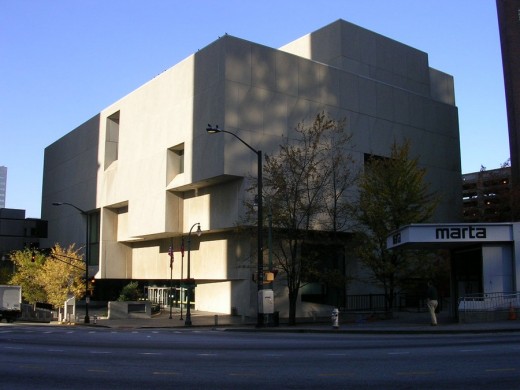
photo : Wikimedia Commons
Website:Met Breuer New York City
According to The Met Breuer:
“The Metropolitan Museum of Art’s modern and contemporary art program includes a new series of exhibitions, performances, artist commissions, residencies, and educational initiatives in the landmark building designed by Marcel Breuer on Madison Avenue and 75th Street. Now open to the public, The Met Breuer provides additional space for the public to explore the art of the 20th and 21st centuries through the global breadth and historical reach of The Met’s unparalleled collection.”
Former Whitney Museum of American Art
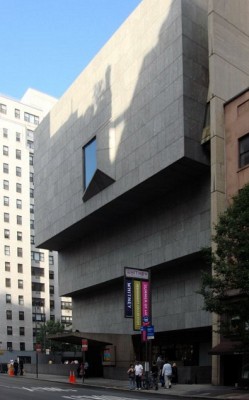
photo : Wikimedia Commons
According to Wikipedia:
“The Whitney Museum of American Art – known informally as the “Whitney” – is an art museum located in Manhattan. It was founded in 1931 by Gertrude Vanderbilt Whitney (1875–1942), a wealthy and prominent American socialite and art patron after whom the museum is named. From 1966 to 2014, the Whitney was located at 945 Madison Avenue at East 75th Street in Manhattan’s Upper East Side. The museum closed in October 2014 to relocate to a new building designed by Renzo Piano located at 99 Gansevoort Street at Washington Street in the West Village/Meatpacking District neighborhoods of Lower Manhattan; it reopened at the new location on May 1, 2015. In May 2011, the Metropolitan Museum of Art announced it had entered into an agreement to occupy the Madison Avenue building for at least eight years starting in 2015, easing the Whitney of the burden of having to finance two large museum spaces. The occupation of the old space was later postponed to 2016.”
Met Breuer New York Building Renewal Architects – Beyer Blinder Belle, USA
Whitney Museum Architect – Marcel Breuer
According to ny.curbed.com
“Beyer Blinder Belle, an architecture firm known for its work in historic preservation, was brought on to restore the building, which first opened its doors in 1966. “Working on this project was similar to working on a piece of art,” John Beyer, one of the founding partners of the firm, told Curbed. “We spent a long time researching Breuer, and his other works apart from this building. The goal was to be extremely careful and gentle, and not over restore the structure”.”
Website: Met Breuer New York City Reopening – article in ny.curbed.com
Whitney Museum of American Art building, Gansevoort St, Meatpacking District, Downtown Manhattan
2008-
Design: Renzo Piano of RPBW
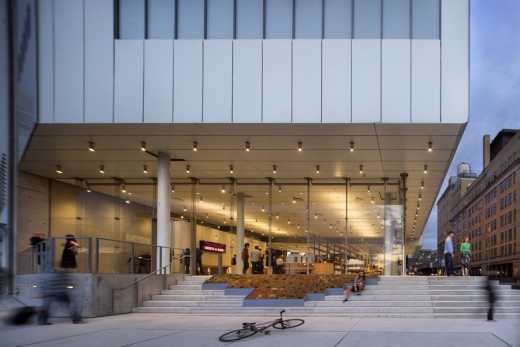
photograph © Nic Lehoux
Whitney Museum of American Art New Building by architect Renzo Piano
Renzo Piano’s Whitney New York Building
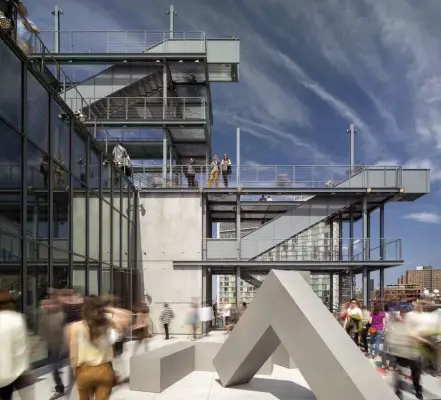
photograph © Nic Lehoux
Visit The New Renzo Piano Whitney Museum
Marcel Breuer is also famous for having designed elegant chairs similar in style to the Modern furniture of architects Gropius and Mies van der Rohe.
Whitney Museum New York – About Marcel Breuer & The Breuer Building
The Met Breuer, Manhattan
Project Description:
In March 2016, The Met Breuer (pronounced BROY-er) becomes the new home for The Metropolitan Museum of Art’s expanding modern and contemporary art program. Through exhibitions, artist residences, and performances, The Met Breuer invites visitors to engage with art of the 20th and 21st centuries through the global breadth and historical reach of the Museum’s unparalleled collection and scholarly resources.
Public Opening:
March 18, 2016
Location:
The Met Breuer
945 Madison Avenue
New York, NY 10021
Programming:
Under the direction of Thomas P. Campbell, Director and CEO of The Metropolitan Museum of Art, Sheena Wagstaff, Leonard A. Lauder Chairman for Modern and Contemporary Art, has developed the curatorial program at The Met Breuer in partnership with departments from across the Museum.
Exhibitions include thematic surveys addressing issues that stretch across history and geography as well as major monographic presentations. The Met Breuer also hosts performances and an artist-in-residence series as well as other educational and public programs.
The inaugural 2016 exhibition season includes:
Unfinished: Thoughts Left Visible (March 18 – September 4, 2016)
Co-curated by Andrea Bayer, Jayne Wrightsman Curator in the Department of European Paintings; Kelly Baum, Curator in the Department of Modern and Contemporary Art; and Nicholas Cullinan, former Curator in the Department of Modern and Contemporary Art, under the direction of Sheena Wagstaff
Nasreen Mohamedi (March 18 – June 5, 2016)
Curated by Roobina Karode, Director, Kiran Nadar Museum of Art, New Delhi, with Sheena Wagstaff and Manuel J. Borja-Villel, Director, Museo Reina Sofía, Madrid
Relation: A Performance Residency by Vijay Iyer (March 18 – 31, 2016)
Commissioned by MetLiveArts
diane arbus: in the beginning (July 12, 2016 – November 27, 2016)
Curated by Jeff L. Rosenheim, Curator in Charge of the Department of Photographs
Kerry James Marshall: Mastry (October 25, 2016 – January 29, 2017)
Co-curated by Ian Alteveer, Associate Curator in the Department of Modern and Contemporary Art; Helen Molesworth, Chief Curator, Museum of Contemporary Art, Los Angeles; and Dieter Roelstraete, former Manilow Senior Curator, and Abigail Winograd, Research Associate, Museum of Contemporary Art Chicago
Inhabiting Marcel Breuer’s Architecture: Four Public Buildings Photographed by Luisa Lambri and Bas Princen (opening November 29, 2016)
Curated by Beatrice Galilee, Daniel Brodsky Associate Curator of Architecture and Design, in the Department of Modern and Contemporary Art
Inaugural performances include:
Soundwalk 9:09 by John Luther Adams (ongoing from March 1, 2016)
U.S. Premiere of KLANG by Karlheinz Stockhausen (March 25 and 26, 2016)
The Met Breuer Architect’s Statement
Revitalization of The Met Breuer
New York, NY
Marcel Breuer was at the height of his career when he designed a third home for the Whitney Museum in 1966 and was the recognized master of using what he called “close to Earth materials,” particularly stone and concrete, which are so eloquently combined in this building.
The privilege of restoring this iconic building and helping to transform it into The Met Breuer has been an immersive task, including extensive research and an understanding of Breuer’s approach to design and materials. His belief that materials become more dignified over time
through weathering and use has guided our work.
While the building is modest in size (29,000 square feet of gallery space), it is bold – often called brutalist – but at the same time intimate, almost domestic in scale, with an integrity and honesty of design and execution that places it among the top mid-century modern buildings in New York. The dramatic form of the inverted pyramid and the two-story high glass wall facing Madison Avenue were intended by Breuer to “receive the visitor before entering the building.”
The overall goal has been to approach the restoration as Breuer himself would have, carefully preserving the authentic patina of aging materials and allowing visitors to understand and appreciate the building’s evolution over time.
Planning for the lobby for The Met Breuer has focused on enhancing both circulation and the visitor experience. Retail has been minimized and visitors are provided with free access throughout the lobby and lower level. A new, specially designed ticketing desk and ticketing kiosks help to minimize waiting times for entry to the museum.
The restoration of the public interior spaces and exterior Sunken Garden was undertaken with a consciously conservative approach. Inappropriate or obsolete interventions made after 1966 have been removed and new interventions are limited and contemporary, and capture the spirit of Breuer’s aesthetic and intent. Our focus has been on restoring the building’s signature attributes, including concrete walls, bluestone floors, bronze fixtures, wood handrails, and lighting. The restoration carefully distinguishes patina from damage, reserving gentle, targeted cleaning for areas that suffered soiling and damage.
To complement the restored interiors, the Design Team created a number of discreet contemporary elements – all inspired by Breuer’s use of sculptural forms and natural materials; these elements are integrated throughout the building to establish The Met presence and introduce a contemporary tone.
We would like to acknowledge the collaboration of the Design Team, composed of The Met Design Department and Beyer Blinder Belle, in addition to The Met Modern & Contemporary Art department, numerous Met administrative departments, and 12 specialized consultants in various technical disciplines.
Beyer Blinder Belle Architects & Planners
Beyer Blinder Belle Architects & Planners was founded in 1968. The practice now totals 195 professionals, with offices in New York City and Washington, DC.
Planning, restoration, and the design of new buildings are the fundamental underpinnings of BBB’s practice. Many of our projects involve the stewardship and revitalization of historic buildings in sensitive urban sites – the work for which we have become best recognized. Firm projects include numerous mid-century modern buildings such as Eero Saarinen’s TWA Flight Center at JFK International Airport, Delano & Aldrich’s Marine Air Terminal at LaGuardia Airport, Junzo Yoshimura’s Japan Society, and Wallace Harrison’s Lincoln Center Promenade.
BBB’s work has been recognized with hundreds of awards, including the American Institute of Architects Firm Award; three Presidential Design Awards; two TIME Magazine Design of the Year Awards; and many national and local awards for design excellence.
March 1, 2016
Address: 945 Madison Ave, New York, NY 10021, United States
Phone: +1 212-731-1675
Location: 945 Madison Avenue, New York City, USA
New York City Architecture
Contemporary New York Buildings
Manhattan Architecture Designs – chronological list
New York City Architecture Tours by e-architect
Key New York Buildings close to the Whitney Museum
Guggenheim Museum
1071 Fifth Avenue, East Harlem, New York
1959
Design: Frank Lloyd Wright Architects
Guggenheim Museum New York
Seagram Building
375 Park Avenue, New York
1958
Design: Ludwig Mies van der Rohe, Architect; Philip Johnson
Seagram Building
New York State Architecture Designs
Whitney Downtown Museum – Design Proposal
Design: Axis Mundi
Whitney Downtown Museum
56 Leonard Street
Design: Herzog & de Meuron, architects
56 Leonard Street
Rockefeller Center
Design: Raymond Hood, Architect
Rockefeller Center New York
Comments / photos for the Met Breuer New York Building – Madison Avenue Architecture page welcome
Whitney Museum – Website: Met Breuer Manhattan

